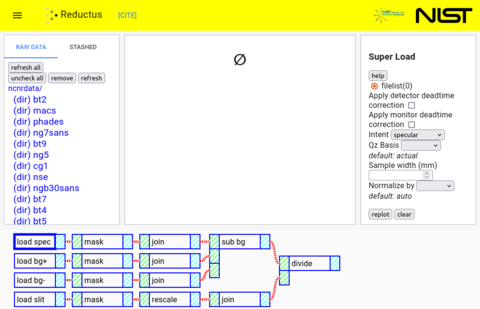Reflectometry Software Installation
Please install/verify the software below on the laptop you will bring to the school:
Analysis: Refl1D
We will be working with the newer "webview" interface for Refl1D. Obtaining a working copy is relatively straightforward, with installation files found at https://github.com/reflectometry/refl1d/releases/sid
Windows Users
- Download the self-extracting executable file here: https://github.com/reflectometry/refl1d/releases/download/sid/refl1d-webview-0.8.15-Windows-x86_64-self-extracting.exe
- Open the .exe file once it is downloaded, and you will be prompted to provide a location on your disk where the application will be installed.
- In the file browser, navigate to that location, and double-click on "refl1d_webview.bat" to launch the application
- A terminal window will open (usually black, with white text), showing the status of the server application
- This window will remain open for as long as the application is running. You can minimize it.
- You can always quit the application by clicking on that terminal window to make it active, then typing "Ctrl-c" (the window will close when the application quits)
- NOTE: the first time it loads, it will take a few minutes (some things are compiling)
- when the application is started, it will automatically open a new browser window (or tab) for the client (GUI) interface
- A terminal window will open (usually black, with white text), showing the status of the server application
Macos Users
- Download the package file here: https://github.com/reflectometry/refl1d/releases/download/sid/refl1d-webview-0.8.15-Darwin-arm64.pkg
- (or here if you have an Intel-based older Mac: https://github.com/reflectometry/refl1d/releases/download/sid/refl1d-webview-0.8.15-Darwin-x86_64.pkg )
- From the Finder, open the .pkg file (you won't be allowed to open it directly from the browser "Downloads" dropdown)
- You will be prompted for your credentials (password or PIV) to allow the installation to proceed
- Once the installation is complete, you will see a folder "refl1d-0.8.15" in the /Applications folder
- inside that folder is a file "refl1d_webview.app" - double-click that to start the application
- A terminal window will open (usually black, with white text), showing the status of the server application
- This window will remain open for as long as the application is running. You can minimize it.
- You can always quit the application by clicking on that terminal window to make it active, then typing "Ctrl-c" (the window will close when the application quits)
- NOTE: the first time it loads, it will take a few minutes (some things are compiling)
- when the application is started, it will automatically open a new browser window (or tab) for the client (GUI) interface
- A terminal window will open (usually black, with white text), showing the status of the server application
Linux/Conda users
- Create a new environment for refl1d:
conda create -n refl1d python=3.11conda activate refl1d
- Install the application:
python -m pip install git+https://github.com/bumps/bumps@webview python -m pip install git+https://github.com/reflectometry/refl1d@webview python -m pip install -r https://raw.githubusercontent.com/bumps/bumps/webview/webview-requirements
- Run the application (must have activated the refl1d environment):
refl1d-webview
Demo version
(limited capabilities, no install required)
https://reflectometry.github.io/refl1d-demo-summerschool24/
Reduction: reductus
Raw reflectometry data at NCNR is processed in the online reductus application, hosted at https://reductus.nist.gov
The application is designed to work in an updated Chrome, Firefox or Safari browser (with JavaScript enabled) Please verify that the site loads and looks like this in your browser, prior to the school:

Please do not hesitate to contact brian.maranville [at] nist.gov (brian[dot]maranville[at]nist[dot]gov) with any questions.

